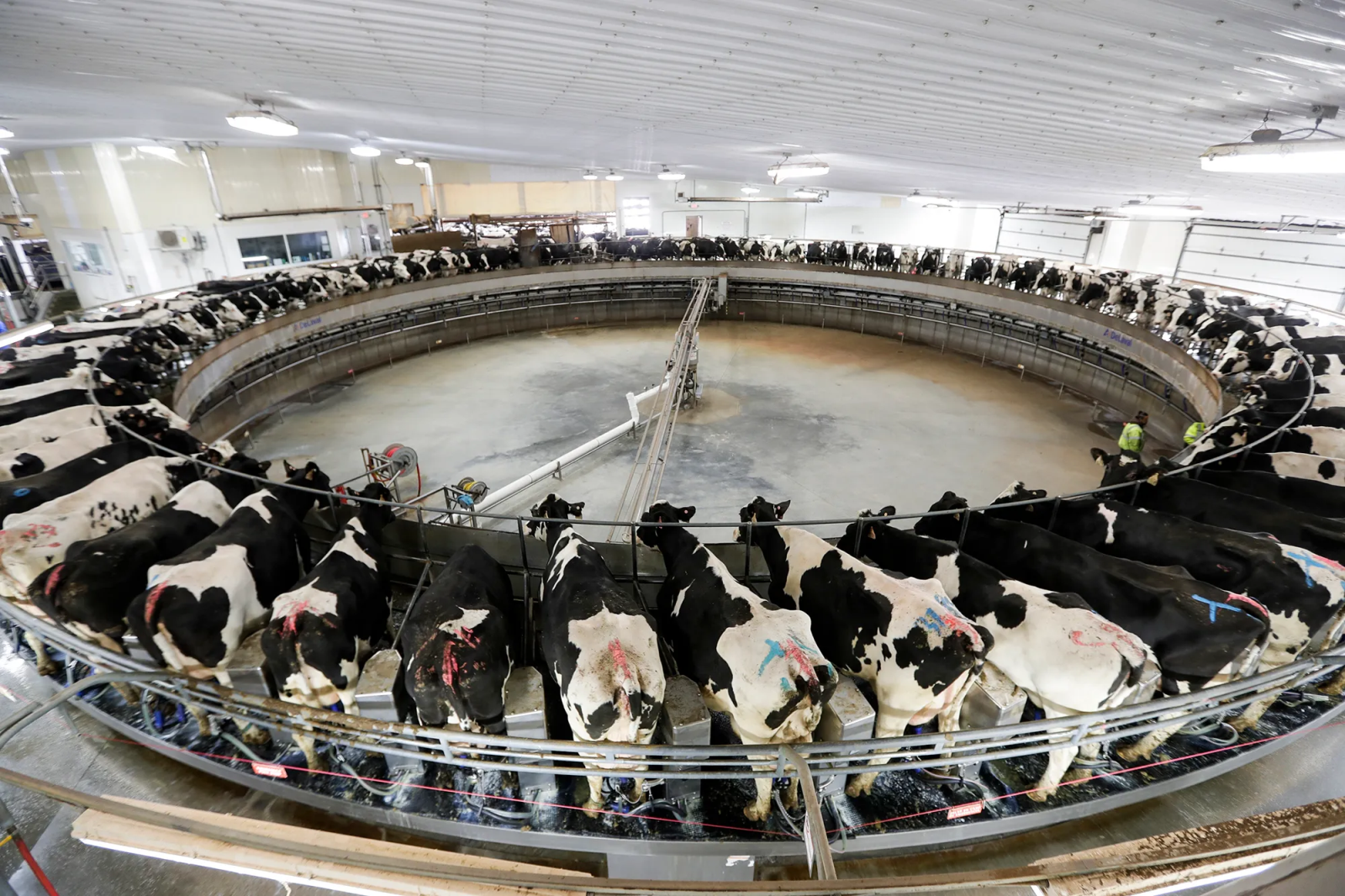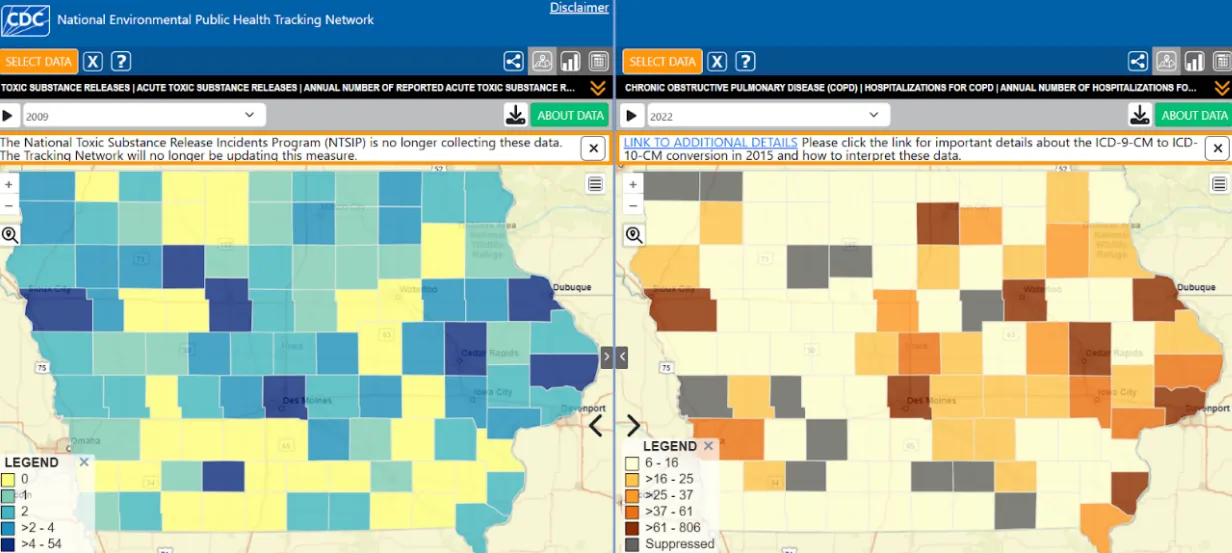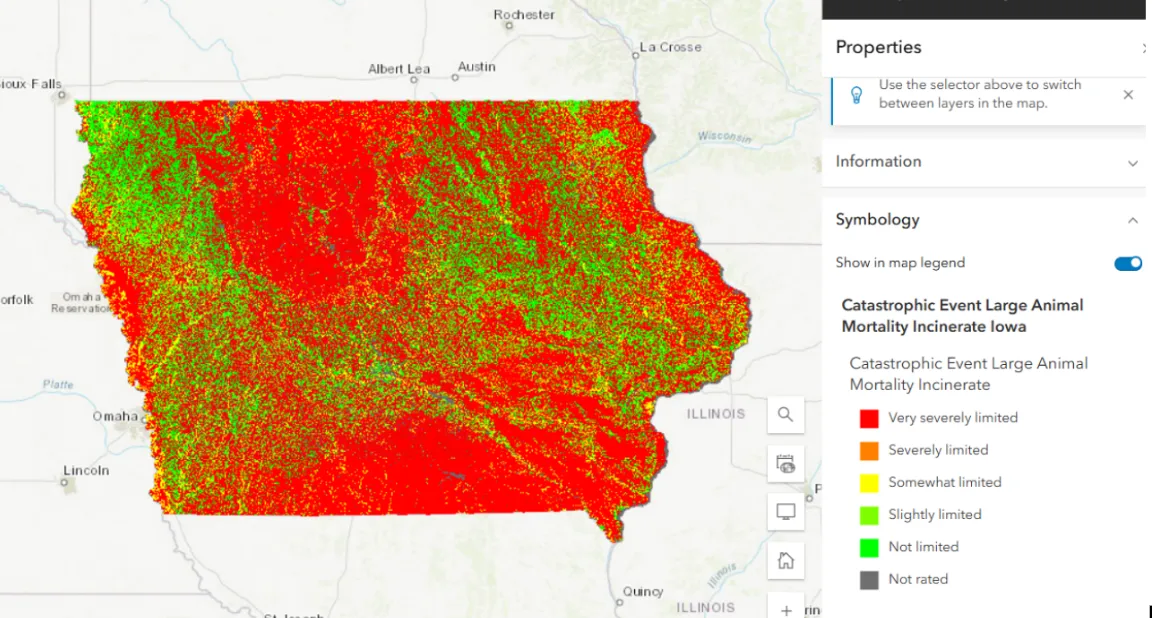Addressing CAFO Pollution Through Enhanced Waste Management and Research Initiatives
posted
by Guest Blogger on Tuesday, July 15, 2025
This guest blog comes from Cindy Bassil, a Chemical and Biomolecular Engineering student at UCLA, graduating in June 2026. Cindy studies environmental contamination, particularly air and water pollution, caused by industrial agriculture, coastal water clarity, and lead in urban soils.
After World War II, American meat production shifted towards industrial farms due to high demand, antibiotics, and the mechanization of agriculture. This increase in Concentrated Animal Feeding Operations (CAFOs), an industrialization of livestock production that keeps large groups of animals in a small area and generates massive quantities of manure.
Waste is typically stored without treatment or aeration, leading to polluted water bodies with high levels of nitrogen and phosphorus. The pollution worsens when waste is transported and sprayed on the ground, leading to polluted drinking water and public health problems such as cancer and respiratory disease. While eliminating these pollutants may cost around $333 million, it is a crucial change to protect long-term living conditions. Large-scale animal farms also pollute the air and give off a very strong odor, significantly reducing residents' quality of life.

Aside from medical issues, CAFO pollution heavily damages the environment by polluting rivers and lakes, killing wildlife, and destabilizing ecological balance. Environmental degradation also kills native economies because it discourages tourism, activities, and recreation such as swimming and fishing. Iowa, being one of the states with the highest concentration of CAFOs, has been highly impacted.
Iowa residents and environmental organizations have been demanding stricter regulations of CAFOs. Activists are demanding a suspension on issuing new permits for CAFOs, stricter pollution controls, and sustainable agriculture policies. Organizations such as the Iowa Environmental Council and the Sierra Club have been mounting public education campaigns and lobbying state policymakers to shift policy toward protecting public health and the environment. But powerful agribusiness lobbies continue to battle tougher rules, so change is not simple. Nonetheless, new environment-based justice campaigns work to obtain cleaner water and more protections for Iowans.
This issue has impacted Des Moines, Iowa, primarily through water contaminated with nitrates. Des Moines, located in Polk County, has only one small farm. Farms, even when situated farther away or in a different county, can still have a significant impact on the local population, which highlights the severity of the situation. An Iowa Environmental Council report shows that CAFOs are the primary source of the contamination, which has been increasing water treatment costs. Des Moines Water Works has found it impossible to screen out such pollutants, and system upgrades would exceed $1 billion in five years. Moreover, CAFOs also pollute the air as they emit toxic greenhouse gases and foul odors, further lowering standards of living for surrounding communities and increasing health issues.
Des Moines County’s Report indicates high public health and environmental justice concerns as measured by the Environmental Justice Index (EJI). It shows that 26.9% of the population lives in places with serious health concerns such as increased rates of diabetes, asthma, and heart disease. They also face many social vulnerabilities, including poverty, unemployment, and unaffordable housing rates. Physical and economic concerns, including excessive flood threat (80th percentile), excess traffic risk (98th percentile), and close location to toxic waste and hazardous waste sites, all play a part in safety and health risks. Such negative synergies call for interventions in infrastructure resilience, economic development, and environmental health to improve the well-being of Des Moines’s residents.

The correlation between acute toxic substance releases and COPD hospitalizations reveals a concerning environmental health trend in Iowa, particularly around urban areas like Des Moines. The release of toxic materials, in our case from farm runoff and large animal confinements, causes bad air quality. It has been established that the majority of toxic materials, such as ammonia, hydrogen sulfide, and particulate matter, worsen respiratory diseases. These exposures can degrade air quality, especially when hazardous chemicals persist. The second map, showing hospitalization rates for COPD, indicates that many of the same areas with high toxic release incidents now face elevated rates of respiratory illness. This shows a potential link between previous environmental contamination and subsequent health impacts (13 years later). The persistence of contaminants or lingering contamination could be the cause of long-term respiratory diseases such as COPD, especially in vulnerable populations like the elderly or those with health conditions.
CAFOs release a significant amount of ammonia from manure lagoons, airborne dust, and other pollutants that can decrease air quality levels dramatically (Burkholder et al.). The correlation shows evidence for the need for more environmental regulations and better air quality monitoring in industrial and agricultural production regions.
Open feedlots exacerbate pollution by allowing direct runoff of nitrogen and phosphorus into nearby water bodies. Underground soil feedlots have the potential to release microbes and nutrients into groundwater sources (Alan L. Sutton). This runoff promotes the growth of harmful algae and unwanted plants, which lower oxygen levels in water bodies, destroy aquatic life, and compromise drinking water quality (Alberta Agriculture and Rural Development). Consumption of water with higher concentrations of nitrates causes serious health issues, like methemoglobinemia, or blue baby syndrome. It’s necessary to monitor the manure to prevent long-term contamination risks. (Sackey et al.) There is a huge number of open feedlots in Iowa, resulting in air pollution through the release of dust, odors, and ammonia, affecting rural and urban communities, including Des Moines.
Open feedlots produce large amounts of manure from concentrated animal populations. Manure applicators spread animal waste onto fields to supply fertilizer to crops, but overapplication may lead to soil saturation, with more runoff and water pollution. If it’s not effectively controlled, the process can help spread pathogens and antibiotic-resistant microorganisms in the surface and groundwater, leading to, again, more pollution in Des Moines.

The Animal Deaths and Incineration map shows that while Des Moines' animal death rate is relatively low, the majority of Iowa has had catastrophic losses. Decomposing carcasses release toxic bacteria, particulate matter PM2.5, and volatile compounds that propagate disease and contaminate water and air sources (Washington State Department of Health). This contamination can travel great distances, affecting remote communities and ecosystems.
Particulate Matter 2.5 is a significant concern. Small particles can cause respiratory and cardiovascular disease, and increase premature mortality rates by penetrating deep into the lungs(EPA). Industrial agriculture and waste treatment are one of the main sources of this air pollution. Not only does it affect the health of individuals, but it also harms the environment. PM2.5 contributes to acid rains, lakes, and streams, ruining the nutrient balance in waters and soil. This damages the forests and farm crops, which impacts the diversity of ecosystems. (United States Environmental Protection Agency).
Environmental and health risks must be minimized by regulating improved corpse disposal methods and emission controls, especially with high impacts. More stringent waste management regulations and increased monitoring should be implemented to prevent these impacts.
After uncovering all these findings - polluted water, toxic air, and health concerns - we wonder, how much longer can we ignore it? Isn’t it time to demand stronger regulations and policy change? An investment in sustainable solutions and smarter waste management is currently a necessity for the safety of Iowans. Because behind every polluted stream is a future at risk.
References
- Alan L. Sutton. (1914, May 8). Animal agriculture's effect on water quality pastures and feedlots. https://www.extension.purdue.edu/extmedia/wq/wq-7.html
- Alberta Agriculture and Rural Development. (2000). Managing feedlot runoff to protect water quality.
- Burkholder, J., Libra, B., Weyer, P., Heathcote, S., Kolpin, D., Thorne, P. S., & Wichman, M. (2006). Impacts of waste from concentrated animal feeding operations on water quality. Environmental Health Perspectives, 115(2), 308–312. https://pmc.ncbi.nlm.nih.gov/articles/PMC1817674/
- Environmental Working Group. (2020). Iowa CAFO interactive map. https://www.ewg.org/interactive-maps/2020-iowa-cafos/
- Flanagan, B. E., Gregory, E. W., Hallisey, E. J., Heitgerd, J. L., & Lewis, B. (2018). Measuring community vulnerability to natural and anthropogenic hazards: The Centers for Disease Control and Prevention's Social Vulnerability Index. Journal of Environmental Health, 80(10), 34-36.
- Herrero, M., Wirsenius, S., Henderson, B., Rigolot, C., Thornton, P., Havlík, P., de Boer, I., & Gerber, P. J. (2015). Livestock and the environment: What have we learned in the past decade? Annual Review of Environment and Resources, 40(1), 177-202. https://doi.org/10.1146/annurev-environ-031113-093503
- Iowa Environmental Council. (n.d.). New report reveals true costs of CAFOs in Iowa. https://www.iaenvironment.org/newsroom/water-and-land-news/new-report-reveals-true-costs-of-cafos-in-iowa#:~:text=The%20report%20looked%20at%20data,systems%20the%20next%20five%20years.
- Sackey, L. N. A., Meizah, K., & Mensah, M. (2024). The impact of landfill operations on borehole water quality. The Scientific World Journal, 2024(1). https://doi.org/10.1155/2024/8899070
- Sierra Club. (n.d.). CAFO moratorium campaign. https://www.sierraclub.org/iowa/cafo-moratorium
- United States Environmental Protection Agency. (2022, August 30). Health and environmental effects of particulate matter (PM). www.epa.gov/pm-pollution/health-and-environmental-effects-particulate-matter-pm
- Washington State Department of Health. (2025). Animal disposal following a flood. https://doh.wa.gov/emergencies/be-prepared-be-safe/floods/animal-disposal
.png)
Cindy Bassil is a Chemical and Biomolecular Engineering student at UCLA, graduating in June 2026. Growing up between Nigeria and Lebanon, she has always been passionate and concerned about environmental issues and access to basic needs, especially clean water. She is currently in the laboratory of Professor Jennifer Jay, where she studies environmental contamination, particularly air and water pollution, caused by industrial agriculture, coastal water clarity, and lead in urban soils.